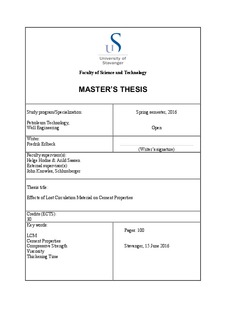| dc.description.abstract | This study aims to find the effect lost circulation materials has on cement slurries through testing in viscometer, pressurised consistometer and static gel strength analyser at selected concentrations. A worksheet containing a basic cement slurry recipe was used as basis for comparison against the slurries containing lost circulation material. SafeCarb 250, OptiSeal II, OptiSeal IV and G-Seal were the materials used to obtain the results for this thesis.
The chosen concentrations for lost circulation material were, by recommendation, 100 kg/m$^3$, 150 kg/m$^3$ and 200 kg/m$^3$. For the thickening time and compressive strength tests, only the highest and lowest concentrations were chosen. All three concentrations were used when conducting tests on the viscometer.
The rheology of the slurries were tested in the viscometers subjected to surface and downhole conditions. It was found that OptiSeal II, containing both graphite and calcium carbonate, had 73,5\% higher viscosity and 15,24\% higher yield stress at surface conditions compared to the base slurry. G-Seal, containing coarse-sized graphite, had 100\% higher viscosity and 56,4\% higher yield stress at downhole conditions. OptiSeal IV, a calcium carbonate, showed the overall lowest values compared to the base slurry with 28,1\% lower yield stress at surface conditions, 32\% lower yield stress and 8,36\% lower viscosity at downhole conditions.
Thickening times were tested in a pressurised consistometer. Tests showed that the addition of SafeCarb 250, a calcium carbonate, decreased thickening time with 18\% as concentrations of SafeCarb increased.
Compressive strengths were tested in a static gel strength analyser. All materials containing calcium carbonate achieved a higher compressive strength than the base slurry. OptiSeal II was 47,5\% higher than base slurry on the highest concentration. G-Seal had a 34\% lower compressive strength on the lowest concentration but exceeded the base slurry again at the highest concentration. | nb_NO |

